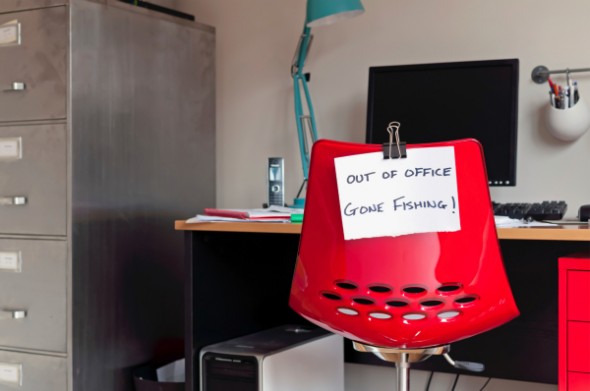Were you drawn to life as a freelancer so that you could be independent and leave the 9 to 5 grind behind? Did you think you would have a flexible schedule that would let you take time off whenever you wanted? What no one probably explained was that as an independent contractor, you would probably end up working more hours than someone who works for an employer, especially when you include administrative and marketing tasks into the mix. The idea that a freelancer can take time off is one that can become increasingly foreign and more than a bit scary once you start getting more involved in the business.
You get scared that you’ll lose your momentum or that the clients you have worked so hard to cultivate will simply go elsewhere if you decide to take even a few days off. We tend to forget that our clients don’t work 24/7 and they probably don’t expect us to, either. (If we land a client who does expect us to put in those kinds of hours, then we need to do something about the types of clients we are agreeing to work with.) Taking some time off from your business is healthy, and people who don’t do it run the very real risk of becoming burned out.
Make a Plan so you Can Take Time Off
Block off Vacation Times in your Calendar
Decide when you are going to be off work – whether you are actually going to be going away or not – and block them off your calendar. Do it now. You are not available for any client projects during that time.
If the idea of blocking off two or three weeks at once doesn’t work for you because of your clients’ needs, your cash flow or you can’t shut off your own workaholic tendencies (and I would probably be guilty on all three counts), start with taking shorter breaks. Take a morning or an afternoon off if you aren’t used to taking breaks and work up to an entire day that you can string into a long weekend that isn’t attached to a holiday. Gradually, the idea of taking a longer break won’t seem to overwhelming.
Tell your Clients About your Plans
Unlike an employee, you don’t need to ask for permission to take time off. If you are planning to be away for longer than a day or two, let your clients know well in advance when you plan to be away and when you will be back at work.
Options for Dealing with Client Work While you are Away
Depending on the types of projects you work on, and your clients’ preferences, there are a number of ways you can deal with their projects while you take a break:
1. Work Ahead
Bloggers can get posts uploaded and scheduled in advance so that they can take time off without anyone realizing that they aren’t posting on the day the post goes “live.” Unless you are working on posts that especially time-sensitive, this approach can work very well.
2. Get Existing Projects Finished
If you know you will be going away in a month or six weeks (or less), do what you have to and push through to get existing projects finished and billed before you go. Clients who contact you about new work should be made aware of your plans and put on the schedule for after your return.
3. Pause Long-term Projects
In the case of long-term projects, try to plan your break at a point in the work that makes logical sense, if possible. Hopefully you have worked out an arrangement where you are billing your client at specific milestones or you are sending monthly invoices for the work you have completed. Do submit your completed work to your client before you leave and confirm when you will return.
4. Arrange for Backup from a Trusted Colleague
Have someone whose work you are very familiar with act as your backup while you will be taking your time off. This person will need to be someone you trust implicitly, since you will be giving your clients his or her contact information in case they need anything done on an urgent basis in your absence. When your backup wants to take some time off, you can do the same thing for them.
Following these steps will allow you to step back from your freelance writing business and take the breaks you need to rest and get recharged so that you can continue to offer the best service possible for your clients.
Image Credit: istockphoto.com
Image Credit: istockphoto.com



Leave a Reply